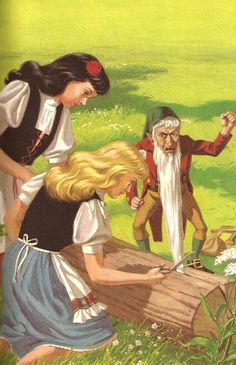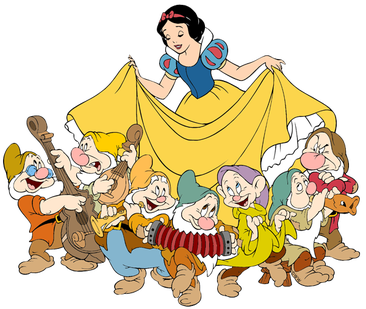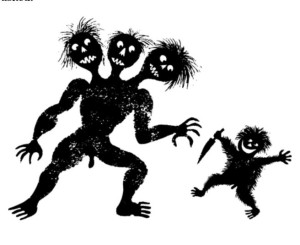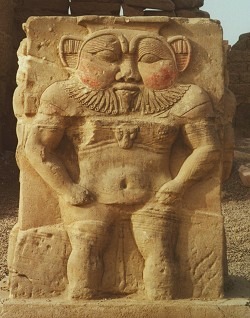|
The dwarves of fairy tale and fantasy literature are characterized by their short stature and impressive beards. Tolkien defined the trope, and Disney undoubtedly helped by portraying six of Snow White's seven dwarves with full beards. In some stories, even female dwarfs are frequently supposed to have similar amounts of facial hair. Other little folk are similar, like garden gnomes with their white beards and leprechauns with red beards. Unlike the people of Europe who told stories of gnomes and leprechauns, Native American men rarely wore beards. However, in such countries there are stories of excessively hairy little people, like the Anishinaabe's Memegwesi, the Lakota's Wiwila Men (in some versions) or the Metis tale of the adventurous and womanizing "Little Man with Hair All Over" (a version of The Bear's Son, Type 650A). Tolkien based his dwarves on the dwarfs of Norse myth. However, Norse and Germanic dwarfs may not have originally been the short beings we immediately picture today. Still, the bearded dwarves we know today go back a long way. For instance, the ancient Egyptian god Bes had achrondroplasic proportions and was one of the few Egyptian deities depicted with a full set of facial hair. (James Romano theorizes that Bes is visually descended from a lion, which would explain his sometimes manelike 'do.)  Through export, Bes would become a popular deity with other peoples such as the Phoenicians and the Cypriots. In the 5th century BC, Ctesias described Indian pygmies two cubits tall, who raised livestock that was similarly small, and had a war going on with some cranes. These pygmies had grew their hair out to their knees and their beards past their feet, so long that they did not require any other clothing. There may have been seeds of truth in this story. Dwarfs in Arthurian romances were frequently described with beards, and in folklore throughout Europe, dwarves were described and drawn as little old men with long beards. Other examples:
So why do dwarves have beards? Facial hair makes it immediately clear that despite his small size, the dwarf is not a child but a miniature adult. Such illustrations leave no room for confusion. (Fairies, who are not typically shown with beards, are usually more childlike and/or feminine.) From there, the exaggeration takes over. Sometimes the beard's length becomes purely silly and imaginative, as in stories where the tiny man's beard is longer than he is and trails on the ground like a parody of Rapunzel's hair. Some readers - from Jane Yolen on Rumpelstiltskin, to numerous critics of Tolkien's gold-loving dwarves - have suggested that these bearded dwarves are anti-Semitic caricatures. Jews in the Middle Ages were frequently depicted wtih beards. However, the trope of the bearded dwarf is so widespread and so old that it seems unlikely that they were all based on Jews. I think it's more likely that they were based on real people with achondroplasia, or real pygmy tribes. I feel like I should also mention that there was a story published by the Grimms called "The Jew in the Thorns," which featured both a bearded, thieving Jewish man and a supernatural-type dwarf who helped the hero get revenge on him. The beard is a symbol of wisdom and age. According to SurLaLune, a beard can also symbolize magical powers or invulnerability, or a sign of a somehow animal nature. The hairy little people of many Native American lores could have been influenced by Europeans coming over, but hair can still be a mark of physical maturity, as well as, again, a sign that the being is more like an animal than a human. In Snow White and Rose Red, the dwarf's beard is the source of his power. He catches it in a crevice in a tree and in a fishing line, and the girls cut it off to free him, taking his powers away in the process. Along the same lines, in the Pomeranian "Das Wolfskind," an ugly little man with a long black beard is poisoning people's food. The hero, Johann, traps the dwarf's beard in a split block of wood, and later hangs him by the beard from the ceiling and treats him like a tetherball (Jahn). This is type 650A. Here we see the beard as a physical manifestation of power. When someone else gains control of it, he is quickly left emasculated and powerless. There is definitely room for some Freudian reading here. Ultimately, my instinct is that the simplest explanation is the best: dwarves were drawn with beards so that nobody would mistake them for children. Egyptian art of Bes, for instance, sometimes had childlike attributes (such as going naked or wearing a lock of hair on the right side of his head). He could have easily been mistaken for a child had he not been drawn with facial hair (Åkerblom 15). And it just went from there, until beards were a defining characteristic of fairytale dwarves. SOURCES
3 Comments
|
About
Researching folktales and fairies, with a focus on common tale types. Archives
July 2024
Categories
All
|
Writing in Margins



 RSS Feed
RSS Feed
